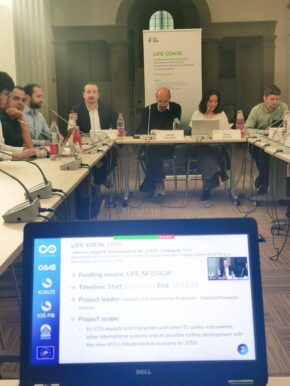LIFE VIIEW 2050 at LIFE COASE “Ex-Ante Assessments of Emissions Trading” workshop in Florence
From June 5th to June 6th 2023, the CAKE/KOBiZE/IOŚ-PIB team consisting of R. Jeszke, M. Pyrka, J. Witajewski-Baltvilks, and I. Tatarewicz participated in the Ex-Ante Assessments of Emissions Trading workshop. The meeting, organized by the Florence School of Regulation at the European University Institute, took place in Florence. In addition to the CAKE team, the hosts S. Borghesi, A. Ferrari, M. Raude, L. Heinrich (EUI), and other guests S. Osorio (PIK), C. Ramsay-Collins (DESNZ), Da Zhang (Tsinghua University), P. Pineau (HEC Montréal) also attended.
The meeting began with a brief introduction by a representative of the hosts, followed by Robert Jeszke’s presentation on “Modelling the European Union Emission Trading System and the Carbon Border Adjustment Mechanism,” which presented key results obtained within the LIFE VIIEW 2050 project.
 Subsequently, S. Osorio gave a presentation on “LIMES-EU: A tool to understand better the EU ETS challenges,” discussing the use of the LIMES-EU model to assess the functioning of the Market Stability Reserve (MSR), the size of surpluses, and the supply of allowances in the EU-ETS system. The key conclusions from S. Osorio’s presentation regarding the functioning of the EU ETS and decarbonization are presented below:
Subsequently, S. Osorio gave a presentation on “LIMES-EU: A tool to understand better the EU ETS challenges,” discussing the use of the LIMES-EU model to assess the functioning of the Market Stability Reserve (MSR), the size of surpluses, and the supply of allowances in the EU-ETS system. The key conclusions from S. Osorio’s presentation regarding the functioning of the EU ETS and decarbonization are presented below:
– After the implementation of the Fit for 55 package, the pool of allowances in the EU ETS will be exhausted by 2039, whereas in the scenario without reform, it will only be exhausted by 2059.
– Due to the operation of the MSR, allowances are still being released into the EU ETS market after 2039. However, there is a long pause in access to allowances, and the MSR only returns allowances in 2045, 2046, 2047, and 2049 (100 million EUAs each).
– The MSR absorbs a total of approximately 7.9 Gt EUAs, of which 7.5 Gt EUAs are cancelled.
– The high price of EUAs provides a strong incentive to bank EUAs, resulting in a high surplus (TNAC) for many years, and emissions remain significantly below the cap, especially around 2030.
– The majority of reductions occur in the current decade: emissions by 2030 are 65% lower than in 2020. The electricity sector is practically fully decarbonized by 2030 (meaning the complete phasing out of coal across the EU by 2030). Industrial emissions will decrease by 36% between 2020 and 2030. EUA prices will reach the values of 130 EUR/t in 2030 and above 300 EUR/t in 2050.
– Improving efficiency and transitioning to district heating (DH) and electrification using heat pumps (power to heat) are crucial for decarbonizing the building sector.
The third presentation, “BEIS Carbon Price Modelling for the UK Emissions Trading System” by C. Ramsay-Collins, focused on the UK emissions trading system and the estimation (using the POLES model) of MACC curves for individual sectors and periods within the UK ETS.
The next two presentations were held remotely. The first, delivered by Da Zhang, focused on the Chinese emissions trading system, while the second, presented by P. Pineau, focused on the results of a simplified emissions market equilibrium model for the cases of California and Quebec.
After the official conclusion of the workshop, a smaller meeting was held with representatives from EUI to discuss potential collaboration between KOBIZE/IOS-PIB and EUI in future projects.
Back
 Reset ustawień
Reset ustawień Kontrast
Kontrast Widok
Widok Czytelność
Czytelność Czcionka
Czcionka Znaki
Znaki Interlinia
Interlinia Słowa
Słowa Akapity
Akapity Deklaracja dostępności
Deklaracja dostępności









